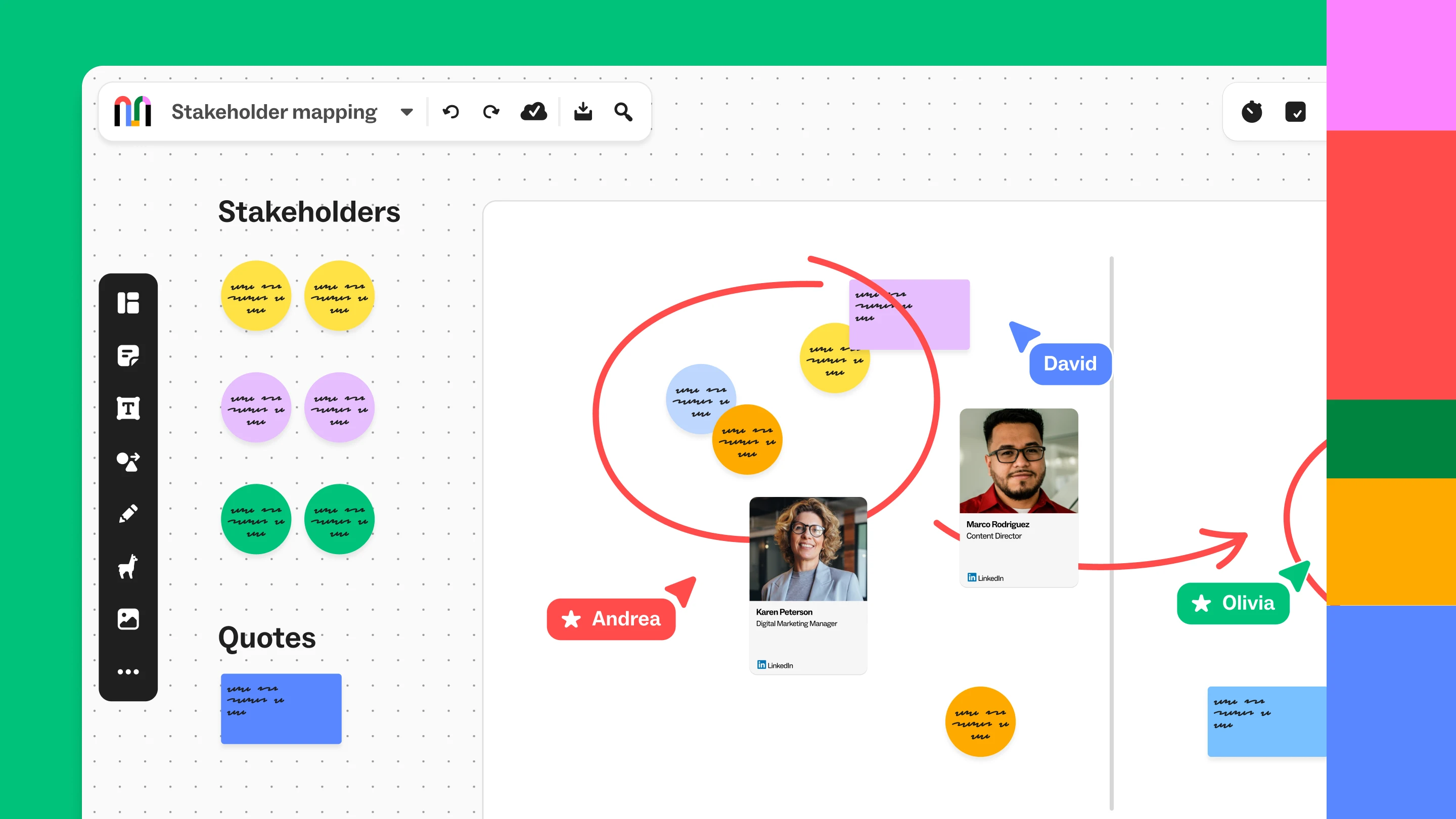Holding a strategic planning meeting is a critical step in setting the goals and direction of a team, company, or organization. It's important to plan ahead and make sure that all stakeholders are included in this process.
In this post, we’ll go over the basics of how to facilitate a successful strategic planning meeting, including resources to help you brainstorm, collect and organize feedback and get alignment on action items:
- What is strategic planning?
- How to facilitate a strategic planning meeting
- Strategic planning session checklist
- Templates for your next strategic planning workshop
Once the agenda, participants, ideas, and outcomes have been established and documented, it is important to review and follow up on the established goals. This can be done through regular meetings, as well as through tracking progress and to ensure that you're achieving your desired outcomes.
What is strategic planning?
Strategic planning is a process that helps an organization or company to set goals, develop strategies, and allocate resources to achieve those goals. It involves setting objectives, determining actions, and evaluating the progress of those actions. Often, these categories can be broken down into 5 concrete steps:
- Define your vision
- Assess where you are
- Determine your priorities and objectives
- Define responsibilities
- Measure and evaluate results
Learn more about each of the above steps in our post on the 5 steps of the strategic planning process.
Strategic planning allows an organization to develop a shared vision for the future and create a roadmap for how to get there. In short, it’s a vital tool for all organizations, whether large or small.
How to facilitate a strategic planning meeting
When running a strategic planning meeting, it is important to set an agenda, identify the participants, and ensure that everyone is on the same page about the goals and objectives of the meeting.
Next, run an icebreaker or warmup to get everyone engaged and your ideas flowing — this also helps to ensure that everyone in attendance has a chance to contribute their ideas and perspectives.
Related: Psychological safety: a critical element for imagination work
Once your participants are warmed up and ready to go, it’s time to get into the heart of the meeting. Here again, the goals and objectives determine the best path when facilitating your meeting:
- Brainstorming: Is it a brainstorming session to help determine project goals and OKRs? If so, what kind of brainstorming approach best fits your topic? For example, it can be useful to start from a template like a vision board when at the outset of a new project.
- Understanding: If you’re looking to drive better cross-functional understanding, use a template like a stakeholder map to see where roles and priorities may overlap, and what working relationships need to be established.
- Evaluating: If you’re in the middle of a project, using a built to help you evaluate your workflows and find ways to improve can ensure that you’re well positioned to deliver on your objectives.
- Empathizing: Are you trying to better empathize with a customer, or look for weak points in a user journey? Using a template for empathy and discovery can be the best way to frame your discussion.
Finally, it is essential to ensure that the outcomes of the meeting are documented and followed up on. With careful planning and preparation, a strategic planning meeting can be a valuable tool for setting the direction of any organization.
Related: 11 top tips for facilitating strategic planning sessions
Strategic planning meeting checklist:
1. Set an agenda for the strategic planning meeting
It is important to set an agenda for the strategic planning meeting to ensure that there is a shared understanding of the goals and objectives of the meeting.
2. Make sure participants are on the same page about the goals and objectives of the meeting
Plan to take a few minutes to get alignment with meeting participants at the outset of a meeting to ensure that everyone is aligned and understands the goals and objectives of the meeting.
3. Begin by going over the agenda and including an icebreaker or warmup exercise
Beginning a meeting with an icebreaker helps to ensure that everyone is engaged and ready to contribute their ideas and perspectives.
4. Set expectations and ground rules
It is important to establish meeting ground rules in order to create an environment of respect and psychological safety, where everyone feels comfortable to contribute their ideas and perspectives.
5. Ensure everyone in attendance has a chance to contribute their ideas and perspectives
Make sure to have a diverse set of ideas and voices participating in your meeting in order to ensure that all perspectives and solutions are taken into consideration.
6. Document the outcomes of the meeting and follow up on them
Having a process for documenting meeting outcomes and following up on any action items is essential for ensuring that your strategic planning meeting is impactful.
Templates for your next strategic planning workshop
When conducting pre-work for your next strategic planning meeting, templates can greatly speed the process of building out your frameworks (as well as helpful in ensuring that you’ve got all the bases covered).
Create a strategy blueprint

The Mural strategy blueprint template is an invaluable tool, crafted to help you brainstorm and analyze six core elements of your strategy. By using this template, you can effectively address your challenges and develop ideas to reach your desired outcome, while exploring your options and trying different alternatives.
It provides a perfect platform to explore multiple solutions, enabling you to pick the one that best suits your needs, while still enabling you to be creative in finding viable solutions. The template offers you an opportunity to think outside the box and develop innovative ideas to tackle your strategy’s most pressing issues. Ultimately, this template allows you to take control of your strategy and create a blueprint for success.
Conduct a SWOT analysis

When assessing where you stand, a SWOT analysis is a great format to brainstorm with your team.
A SWOT analysis is an important exercise where you can evaluate your current situation and better understand the potential opportunities and threats that may arise. It requires you to carefully analyze the internal and external environment in which your initiative or product exists.
- When engaging in a SWOT analysis, you must identify your strengths — what are your unique strengths for this particular initiative or product? In what ways are you a leader? Additionally, you must identify any weaknesses — what weaknesses can you identify in your offering? How does your product compare to others in the marketplace?
- It is also important to identify any opportunities — are there areas for improvement that would help differentiate your business? Finally, you must consider any potential threats — beyond weaknesses, are there existing or potential threats to your initiative that could limit or prevent its success? How can those be anticipated?
By engaging in a thorough and thoughtful SWOT analysis, you can gain valuable insight into the potential success of your initiative or product and be better prepared to respond to any obstacles that may arise.
It’s time for kickoff!

To realize your vision, prioritize and outline specific objectives to achieve your goals. Once you have defined your vision and assessed your current situation, you can begin outlining and ranking your priorities and the objectives associated with them.
Use the Mural project kickoff template to capture everything up front, and give you an easy, shared reference point to return to as you analyze outcomes.
Summary
Strategic planning is a process that helps an organization or company to set goals, develop strategies, and allocate resources to achieve those goals. It involves setting objectives, determining actions, and evaluating the progress of those actions.
This post outlines the basics of how to facilitate a successful strategic planning meeting, including resources to help you brainstorm, collect and organize feedback, and get alignment on action items. But
Get started today with a Mural Free Forever account, and use any of our hundreds of (free and editable) templates to make your next strategic planning meeting more engaging and impactful.

%20(2).avif)


![How to create better team alignment [+ templates]](https://cdn.prod.website-files.com/63062129119620a44791a2eb/6377fbd57972631e7199b6d4_6361727e7d0a7bdc4757f98b_Blog.avif)



